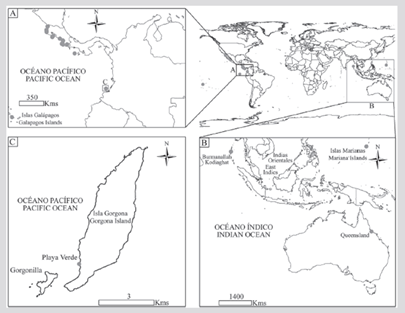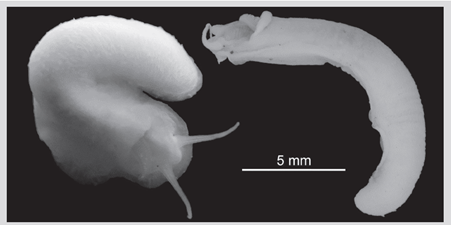Humans have always wondered what the number of species (richness) inhabiting planet Earth is. Although this question is almost unsolvable, in the terrestrial realm and for large animals (e.g., mammals and reptiles) and plants, the answer could be relatively complete. In the marine realm and for small animals and plants, however, it could be more difficult to achieve. Many researchers have tried to solve this task (e.g., Foggo et al., 2003; Bouchet, 2006; Miloslavich et al., 2011; Mora et al., 2011; Appeltans et al., 2012) with striking differences in their estimations. In his chapter, Bouchet (2006) argues that the most common groups of marine animals, like the mollusks, are reaching their estimated number of species, but in a more recent publication, Bouchet et al. (2016), mention that the number of new species of mollusks yet to be described is three times larger than the current number of known and described species (150 000 vs. 50 000) and that at the current pace, it will take at least 300 years to name all the mollusks inhabiting the planet. Hence, even in well-known groups, it is not rare to find records of species new to science (e.g., Tan and Liu, 2001; Tamsouri et al., 2014) or to document the extension of species’ range distributions - new regional records (e.g., Valencia-Giraldo et al., 2015; Muñoz and Londoño-Cruz, 2016; Londoño-Cruz et al., 2018), in regions where specialists or research efforts or both are scarce.
The mollusks, one of the richest and more abundant animal groups in the marine realm, include among others, the snails (class Gastropoda), some of which have partially or completely lost their protective shells. The snails with this characteristic are usually known as sea-slugs and most are confined to the subclass Heterobranchia. One remarkable exception is the genus TitiscaniaBergh, 1890, belonging to the subclass Neritimorpha. The closest relatives to this exception are the heavily shelled snails of the genera Neritiopsis Grateloup, 1832 and Nerita Linnaeus, 1758, which are common intertidal snails of the rocky shores. The genus Titiscania (Neritopsidae) comprise two species: T. shinkishihataii and T. limacina. The former was originally described from Japan and is restricted to East Asia, while the latter has been reported in several regions across the Indo-Pacific (GBIF Secretariat, 2019). Apart from the records in the GBIF, two other are available: one from Kodiaghat and Burmanallah in India (Apte and Nerurkar, 2016) and the other from Puerto Ayora, Santa Cruz, Galápagos Islands, Ecuador (Templado and Ortea, 2001). In the Tropical Eastern Pacific (TEP), this species has been reported only in México, Costa Rica, Panamá, and Ecuador. Hence, this is the first record of this species in Colombia (in Gorgona island), which along with islands of the last three countries (Cocos Island, Costa Rica; Coiba Island, Panamá; Galápagos Islands, Ecuador, plus the Colombian Malpelo Island) constitutes the Marine Corridor of the TEP.
During a field campaign in 2019/08/31 for monitoring of the rocky shore ecosystems, using SARCE protocol (2012), at the Gorgona National Natural Park (Figure 1), one specimen of a white nudibranch-like sea-slug was found underneath a rock of approximately 38 × 22 cm in the low intertidal of the site known as Playa Verde (2.947517 °N; -78.198133 °W). The specimen was collected and stored in a plastic container with seawater. Later, it was observed under a stereomicroscope and photographed (Figure 2). Next, it was relaxed with the gradual addition of freshwater to the containing recipient and, after death, fixed and preserved in 97 % ethanol. At the laboratory, the specimen was measured, photographed, and stored in the Reference Collection of Marine Organisms (Biology Department, Universidad del Valle, Cali, Colombia).

Figure 1 Localities where Titiscania limacina has been recorded, showing its distribution in the TEP (A), the Indo-Pacific and West Pacific (B), and the site at Gorgona Island (C) on the Pacific coast of Colombia. Data from GBIF https://doi.org/10.15468/dl.6hgpgh Templado and Ortea (2001); Apte and Nerurkar (2016).

Figure 2 Titiscania limacina alive (left) and preserved (right). The tentacles, eyes, and gill are easily seen. Scale bar is for the picture of the preserved animal. Preserved specimen picture (©Laboratorio de Imágenes, Posgrado en Ciencias-Biología, Universidad del Valle, Ortega and Londoño-Cruz).
According to WoRMS (2020), the following is the current, valid, and accepted taxonomy for the specimen collected at Gorgona Island:
Class Gastropoda Cuvier, 1795
Subclass Neritimorpha Golikov & Starobogatov, 1975
Order Cycloneritida Frýda, 1998
Superfamily Neritopsoidea Gray, 1847
Family Neritiopsidae Gray, 1847
Subfamily Neritopsinae Gray, 1847
Genus TitiscaniaBergh, 1890
Species Titiscania limacinaBergh, 1890
In the field, although not measured, the specimen ranged from 10 to 15 mm in length. When touched, before collection, the specimen flashed a series of evenly spaced white dots along parallel lines on its back (notum), extending almost four-fifths of the length of the body from head to tail. This behavior and the fact that the animal secretes a defensive substance (not observed this time) from those dots have been reported elsewhere (Templado and Ortea, 2001; Apte and Nerurkar, 2016).
The identification of the specimen was possible thanks to a picture depicted in the poster: “Strange and unusual small molluscs from Madang”. The poster came from the Papua Niugini expedition, led by Dr. Philippe Bouchet from the Muséum National d’Histoire Naturelle (Paris, France). After a short communication, Dr. Bouchet confirmed the identification of the specimen collected at Gorgona as Titiscania limacina. The identification was reconfirmed following the description in Bergh (1890). At the laboratory, the fixed specimen measured 17 mm in length (Figure 2). It was included in the collection with the number CRM-UV:RMO2019-041.
Given the currently known figures, the TEP is not regarded as a highly biodiverse marine region, at least compared to the Indo-Pacific and the East and West Tropical Atlantic (Bouchet et al., 2016); however, its marine biodiversity could be underestimated because the taxonomic research efforts are rather languid as compared, for example, to the Indo-Pacific. In Colombia, the Pacific coast has historically lagged behind the Caribbean coast in biological research. The difficulty in access (limited transportation) and issues of public security are perhaps the main reasons. These have hindered research in the region for years, except in few sites such as Gorgona Island and Malaga Bay, where scientists have been welcomed and have inventoried much of the biodiversity of well-known biological groups (e.g., fishes, mollusks, and echinoderms). However, even in these groups, new records of uncommon or cryptic species are often reported. López de Mesa and Cantera (2015) reported 426 species of mollusks of which 44 were new records. The report of this sea-slug is just a small contribution, but the recent similar results for the same or similar sites (Valencia-Giraldo et al., 2015; Muñoz and Londoño-Cruz, 2016; Londoño-Cruz et al., 2018) rise hope for promising and interesting results in the biodiversity inventories to come, if more effort and support are put into biological research across the region.
To conclude, this paper reports for the first time the presence of T. limacina on the Pacific coast of Colombia, specifically in the rocky ecosystem of Gorgona Island. This fills a gap in the distribution of this sea-slug in the TEP and confirms its presence in all the countries that are part of the TEP Marine Corridor.











 text in
text in 



